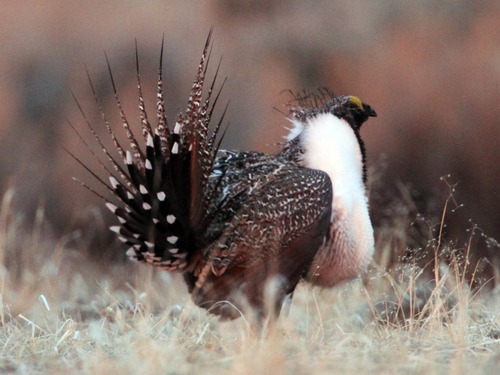This is an archived article that was published on sltrib.com in 2013, and information in the article may be outdated. It is provided only for personal research purposes and may not be reprinted.
They're about the size of a chicken, dine mostly on sagebrush, and make an ungodly racket when spring arrives and the males, with their spiky tail feathers and distinctive yellow neck sacs inflated for effect, strut about in a ritual mating dance. They are Gunnison sage grouse, and they're rapidly strutting their way to extinction.
To arrest a precipitous decline in population and ensure survival of the species, federal biologists have wisely proposed to declare the bird endangered under the Endangered Species Act, and to designate 1.7 million acres in Colorado and Utah as critical habitat for the estimated 4,612 survivors.
Only 103 of the remaining grouse are found in Utah, on 70,000 acres of mostly private land north and east of Monticello in San Juan County. The vast majority nest on patches of southwestern Colorado, where residential and recreation development, new roads and power lines have caused many to cease laying eggs. Most exist on agricultural land, where flying into barbed-wire fences is a common cause of death.
There was no good reason for allowing things to become this dire for Centrocercus minimus, a species that now occupies only about 7 percent of its original habitat. The bird was found to be distinct from the much larger and more numerous greater sage grouse only in the 1970s. The greater sage numbers in the tens of thousands in Utah and 10 other states, though it, too, is under mounting pressure.
Wildlife conservationists had tried for years to get the U.S. Fish and Wildlife Service to list the Gunnison sage grouse, but the agency, under President George W. Bush, denied it protection in 2006, a decision that was later found to have been based on politics, not science. In 2010, the agency said that, yes, the grouse merited protection, but other species were further up the line.
Finally, after conservation groups went to court, a settlement gave the government until Sept. 30, 2013, to decide whether to list the bird as endangered.
A loose coalition of conservationists, private land owners and state and local officials deserve credit for preserving habitat while the federal government dithered. Land purchases, conservation easements and such measures as affixing easily visible markers to the top strand of barbed-wire fences helped keep the grouse a viable candidate for recovery.
A 60-day comment period on the government's proposed plan ends March 12. We urge anyone interested in keeping the Gunnison sage grouse strutting to speak up. How often do we get to help save an entire species?



